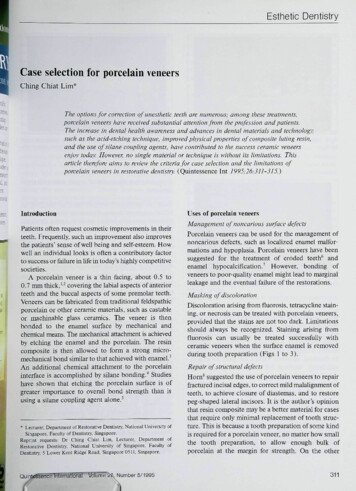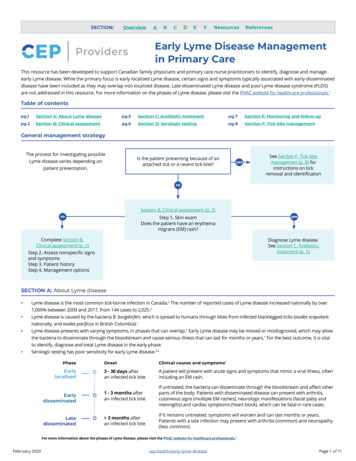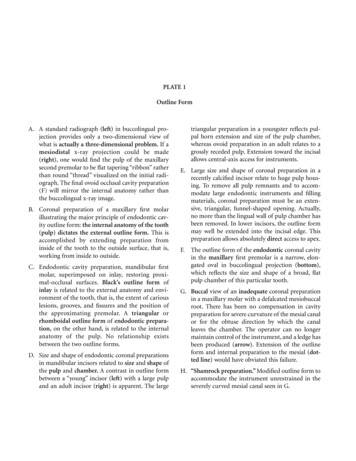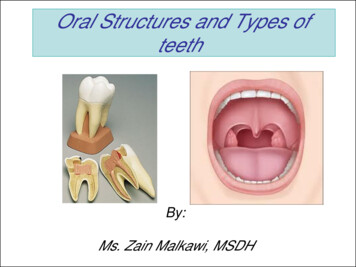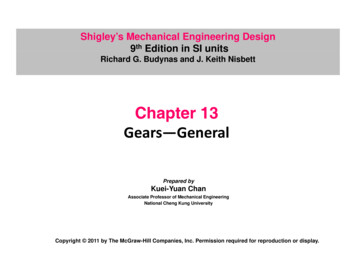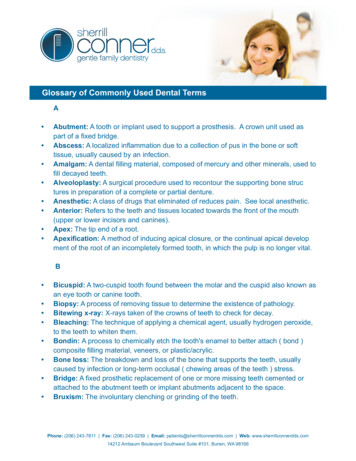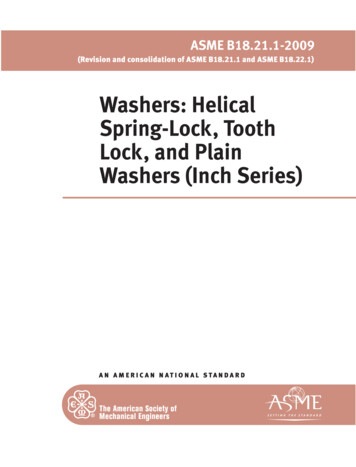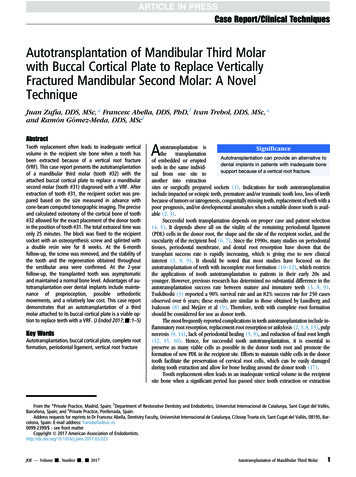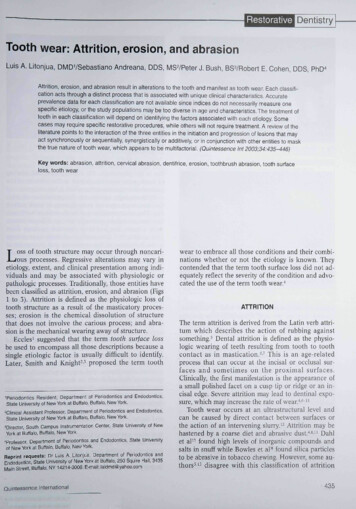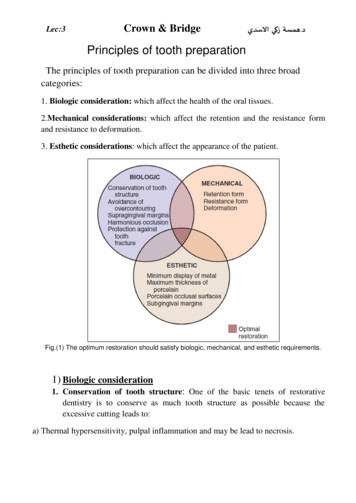
Transcription
Lec:3Crown & Bridge همسة زكي االسدي . د Principles of tooth preparationThe principles of tooth preparation can be divided into three broadcategories:1. Biologic consideration: which affect the health of the oral tissues.2.Mechanical considerations: which affect the retention and the resistance formand resistance to deformation.3. Esthetic considerations: which affect the appearance of the patient.Fig.(1) The optimum restoration should satisfy biologic, mechanical, and esthetic requirements.1) Biologic consideration1. Conservation of tooth structure: One of the basic tenets of restorativedentistry is to conserve as much tooth structure as possible because theexcessive cutting leads to:a) Thermal hypersensitivity, pulpal inflammation and may be lead to necrosis.
b)The tooth might be over tapered or shortened and thus affecting the mechanicalproperties (retention and resistance) of the prepared tooth.2.Prevention of damage during tooth preparation to:a) The adjacent tooth.b) Soft tissue.c) The pulp.a) The adjacent tooth.Iatrogenic damage to the proximal contact area of adjacent tooth makes it moresusceptible to dental caries. Therefore, a metal matrix band put around the adjacenttooth for protection may be helpful but the preferred method is to use a fine, taperedfissure diamond bur to pass through the interproximal contact area leaving a slightlip of enamel without causing excessive tooth reduction.Fig. (2) Damage to adjacent teeth is prevented by making a thin "lip" of enamel as the burpasses through a proximal contact.b) Soft tissues: Tongue and cheeks can be preserved by careful retraction with anaspirator tip, mouth mirror. Using gingival retraction cord to reflect the gingiva incase of subgingival finishing line.c) The pulp: Tooth preparations must take into consideration the morphology and sizeof the dental pulp chamber.Fig.(3) Relationship between tooth preparation and pulp chambersize. The dotted lines represent pulp chamber morphology atvarious ages. A, Maxillary central incisor with a metal-ceramiccrown preparation2
Causes of pulpal damage: Extreme temperature: This is generated by friction between a rotary instrumentand the surface being prepared, and this depends on: Excessive pressure Higher rotational speed Type and condition of cutting instrument.This heat can be minimized by the use of water coolant high speed with lighttouches.Water coolant is useful because it cools the tooth and the bur, and removesthe tooth debris from the cutting blades because clogging reduces the cuttingefficiency and generates more frictional heat. Chemical irritation.Certain dental materials (bases, restorative resins, solvents, and luting agents) cancause pulpal damage when applied to freshly cut dentin. cavity varnish or dentinbonding agents will form an effective barrier in most instances but their effect on theretention of a cemented restoration is controversial. Bacteria irritation.Bacteria that either left behind or gained access to the dentin because ofmicroleakage lead to pulpal damage. Because the vital pulp resist infection, thecommon use of antimicrobial agent such as consepsis after tooth preparation has notbeen documented in clinical trial.3). Preservation of periodontal tissue: which is the most important considerationsfor the future dental health:a) The restoration should have proper contact, embrasure form, occlusion and ahealthy occluso-gingival contour otherwise a persistent gingival inflammationoccur. (Difficult to maintain plaque control by the patient).b) Whenever possible the margin of the preparation (finishing line) should be placedsupragingivally.3
2. Mechanical considerationsThe design of tooth preparations must adhere to certain mechanical principles;otherwise, the restoration may become dislodged or may distort or fracture duringservice.Mechanical considerations can be divided into three categories:1. Providing retention form.2. Providing resistance form.3. Preventing deformation of the restoration.1. Providing retention form:Retention: is the ability of the preparation to resist the removal of the crownrestoration along its path of insertion.Path of insertion: An imaginary line along which the restoration can be inserted andremoved without causing lateral forces on the abutment.The crown restoration should have a single path of insertion to be retentive.Which is mostly parallel to the long axis of the tooth as shown in fig.(4) butsometimes not parallel for example: in 3/4 crown for anterior teeth the path ofinsertion should be parallel to the incisal 2/3 of the tooth crown(not to the longaxis)as shown in fig.(5)Fig.(4)Fig.(5)4
2. Providing resistance form.Resistance: is the ability of the preparation to resist the dislodgment of therestoration by forces directed obliquely or horizontally to the restoration.Factors affecting retention and resistance:1- Taperness of the preparation.2. Surface area of the preparation.3. Length and height of the preparation.4. Diameter of the tooth (tooth width).5. Texture of the preparation.6. Accessary means.1- Taperness of the preparation: The more nearly parallel the opposing wallsof preparation the greater retention will be, but parallel wall is difficult to beobtained in the patient mouth without undercuts, also parallel walls might lead todifficulty in seating of the crown restoration, thus (6̊) degree convergence angle ismostly used to provide the needed retention. To produce an optimal 6ₒtaper orconvergence angle, each opposing axial wall should have an inclination of threedegree to the path of insertion.(fig.6,fig.7).Fig.(6)Fig(7) the degree of taper retention5
Taper and Resistance: The parallel axial walls the more will be theresistant crown restoration (fig.8).Fig.(8)2- Surface area of the Preparation:Increasing the surface area will increase the retention of the restoration.Factors that influence surface area are:a) Size of the tooth: The larger the size of the tooth the more will be the surface areaof the preparation, the more will be the retentionthus full metal crown on molar tooth definitelymore retentive than that on premolar tooth.b) Extend of coverage by restorationThe more the area that will be covered by the crown restoration the moreretention and resistance will be, thus full coverage crown is more retentive&resistant than 3/4 crown restoration on the same tooth.c) Accessory feature: such as boxes grooves and pin hole.3- Length (height) of the preparation:Increasing the length increase retention and resistance and vice versa.6
4-Diameter of the tooth (tooth width):Wider tooth is more retentive than narrower one (increasing tooth width willincrease the retention of crown restoration. Under some circumstances crown onnarrow tooth can have greater resistance to tipping than one on the wider tooth, thisoccur because the crown on the narrower tooth has shorter radius for rotationresulting in a lower tangent line and a larger resisting area.Ex.: The walls of a short widepreparation must be kept nearly parallelto achieve adequate resistance from.5-Texture of the Preparation.Texture of the preparation might affect on the retention of cast crown. Smoothsurfaces less retentive than rough (mechanical interlocking).6- Extra retention means: The retention of a preparation can be greatlyenhanced by the addition of grooves, pin holes or boxes.3. Resistance to deformation:A restoration must have sufficient strength to prevent permanent deformationduring function, so the restoration must has structural durability and marginalintegrity.a).Structural durabilityThe restoration must be rigid enough not to flex, perforate (metal) or even fracture(plastic) during occlusal forces. Sufficient tooth structure should be removed tocreate enough thickness to the ideal occlusion.-Preparation features related to Structural durability:1. Occlusal reduction:7
Occlusal reduction must reflect the geometric inclined planes of occlusal surfacewith bevelling of the functional cusps (palatal cusps of the upper posterior teeth and thebuccal of lower posterior) Fig. (12).Fig.(12)Bevelling of the functional cuspNotes Avoid creating steep planes with sharp angles that lead to stress concentration. Flat occlusal reduction leads to thin metal and perforation in the future. Lowering the entire occlusal surface as an attempt to provide enough space willdestruct the tooth structure.Occlusal clearance: is the space between occlusal surface of prepared tooth andthat of the opposing tooth. It should evaluate in centric and eccentric relation.2. Axial reduction: it must be sufficient to provide enough space to the restoration toduplicate the normal contour of the tooth without flexure during occlusal forces.b).Marginal integrity:The configuration of the finishing line determines the shape and bulk of therestoration margins. The requirements of the restoration margins: It must be well adapted (as fit as possible) to the finishing line of tooth preparation. It must have enough strength.8
Should be placed in the area that is easily polished by dentist and cleaned by thepatient.3. Esthetic consideration:Patients prefer their dental restorations to look as natural as possible.This can be achieved by:1. Minimal displaying of metal collar.2. Maximum thickness of porcelain material will enhance the shade (colour) of therestoration.3. Correct shade selection.4. Porcelain occlusal surfaces, aesthetically no metal appearance is more preferable bythe patient.5. Subgingival margin.9
The principles of tooth preparation can be divided into three broad categories: 1. Biologic consideration: which affect the health of the oral tissues. 2.Mechanical considerations: which affect the retention and the resistance form and resistance to deformation. 3. Esthetic considerations: which affect the appearance of the patient.
